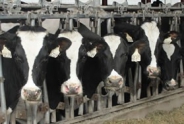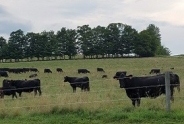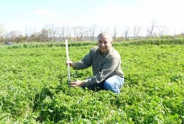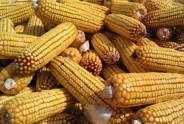Field Crop Update June 11, 2021
Erik Smith, Area Field Crop Specialist/Team Leader
Central New York Dairy and Field Crops
Field Crop Update June 11, 2021
1. Field Observations
Another reminder to protect your winter wheat at full anthesis from fusarium head blight if you've had trouble with it in the past. See the current risk for NY (brown is high):
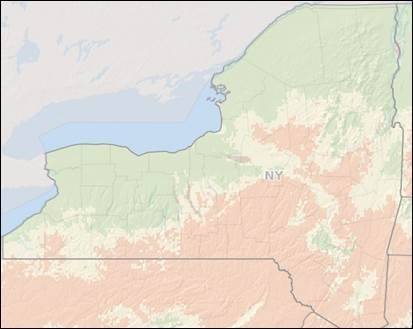
I've seen an abundance of crown rust on buckthorn trees, which means we should keep an eye on spring oats. A number of different rust species can infect buckthorn and not oats, so this is another pest that is difficult to forecast.
Once again, I have yet to see any cereal leaf beetle in the fields I've checked, but that doesn't mean it isn't out there. Our friends in western NY have seen a few fields with lots of leaf beetle mating activity, so if you see any in your field, please let me know! We need to collect some larvae to hopefully reinvigorate what was a very successful biocontrol program that has lost steam over the years. So keep me in the loop….
Soybean aphid may be in the rise as we are likely to have a long period of fair weather (aphids can be washed away by rain). It's been spotted in other parts of the state, so this is another pest to watch for as we get into June. The management threshold is an average of 250 aphids/plant if plant development is prior to early pod fill (R4). Natural enemies can keep lower populations in check, so we should resist the temptation to spray on first sight.
See section 3 for the latest info on alfalfa weevil.
2. Growing Degree Days as of June 2nd (See: Climate Smart Farming Growing Degree Day Calculator)
Growing degree days (GDD) are calculated by taking the average daily temperature and subtracting the base temperature for development of a given organism ((High + Low)/2 - base temp = GDD). For corn silage, we are using base 50/86, as corn development starts at 50 degrees F and ceases above 86.
While the early and late planting dates are seeing GDD accumulations hovering around normal, crops planted in the 2nd-3rd weeks of May are near record GDD. What a difference a week makes:
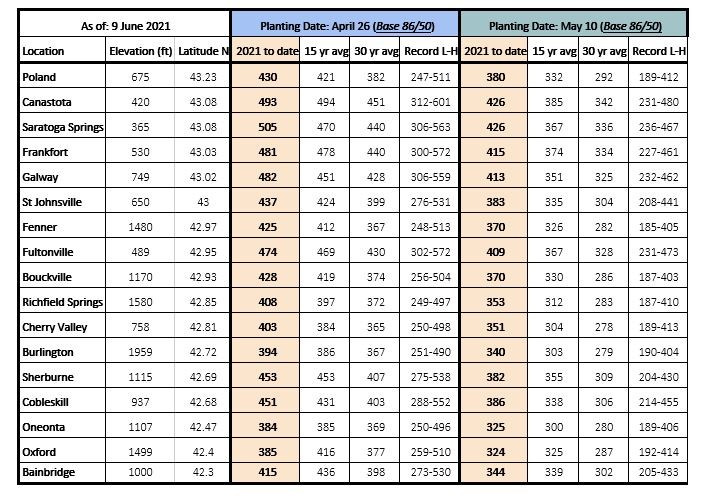
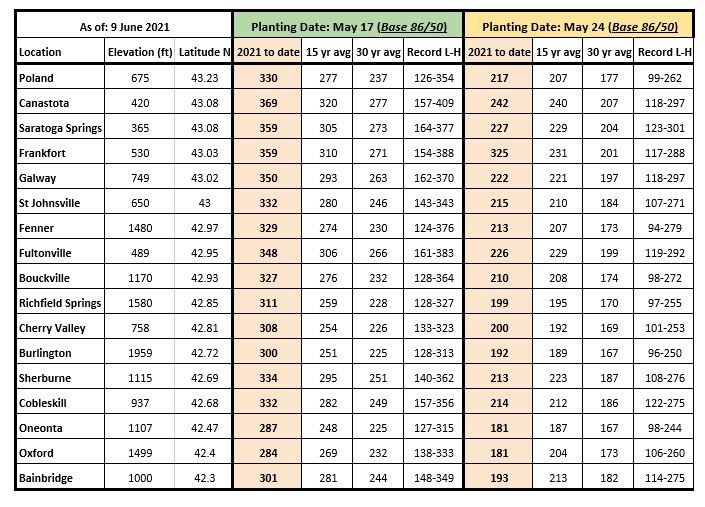
Some of us are still in the "abnormally dry" category in the drought monitor, and while we're forecast to have some thunderstorms in the early part of next week, the 2-week outlook suggests slightly below normal temperatures and precipitation:
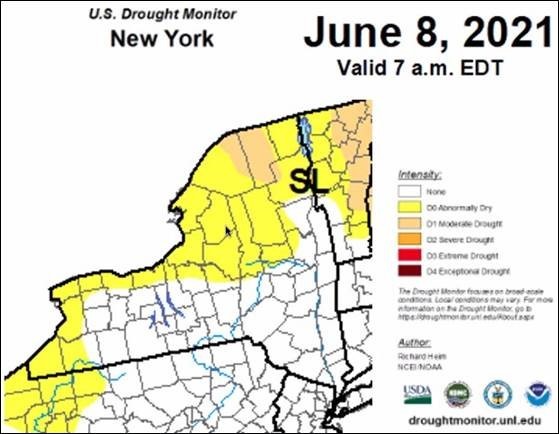
3. Pest Monitoring
So far, potato leafhopper has not yet been a major issue, unlike alfalfa weevil:
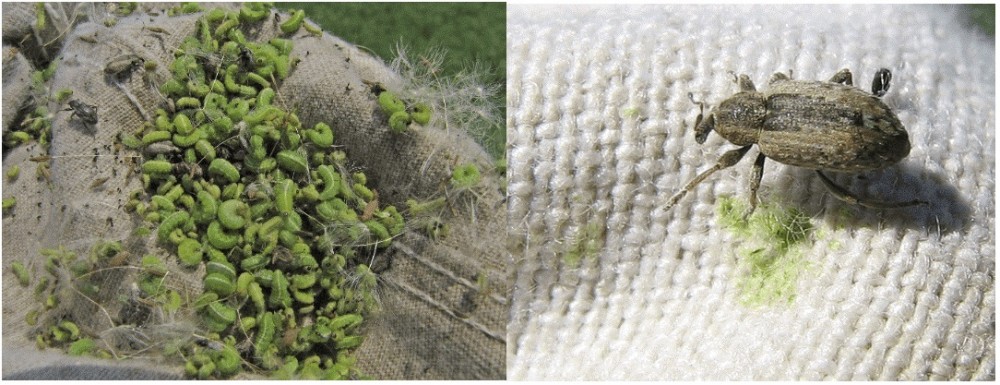
In alfalfa regrowth, the economic threshold is damage to 50% of shoots:
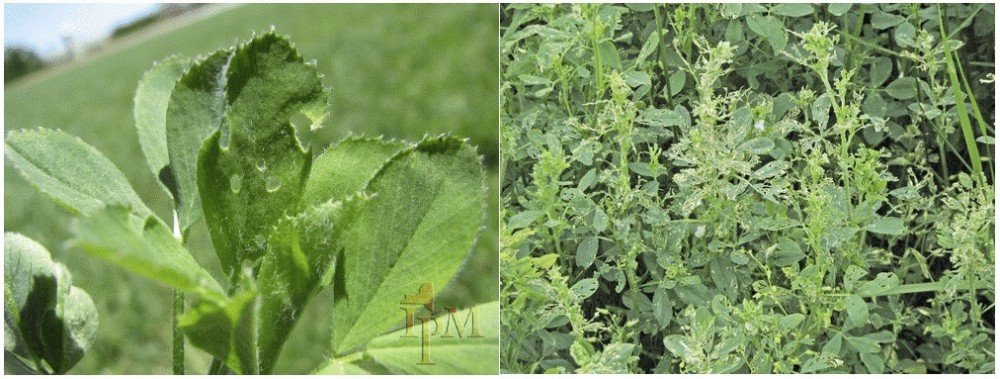
(Photo by Ken Wise, NYSIPM)
Several of our alfalfa weevil and potato leafhopper insecticides have pre-harvest intervals of 7 days, so if you're within 7-10 days of harvest, you may be better off taking an early cutting. The most hard-hit alfalfa I've seen are in mixed stands where grass constitutes 50% or more of the crop. In these cases there's no economic return for spraying, and a spray would knock out the beneficial predators and parasites that would otherwise help suppress weevils in the future. See the following videos for info on alfalfa weevil and potato leafhopper scouting:
#CropCam Scouting for Alfalfa Weevil Larvae
Potato Leafhopper Scouting and IPM Thresholds in Alfalfa
This year we will again monitor for several pests of corn and soybean using pheromone-baited traps, including black and western bean cutworms, true armyworm, and the invasive soybean pests (and as-of-yet undetected) silver Y moth and golden twin spot moth:
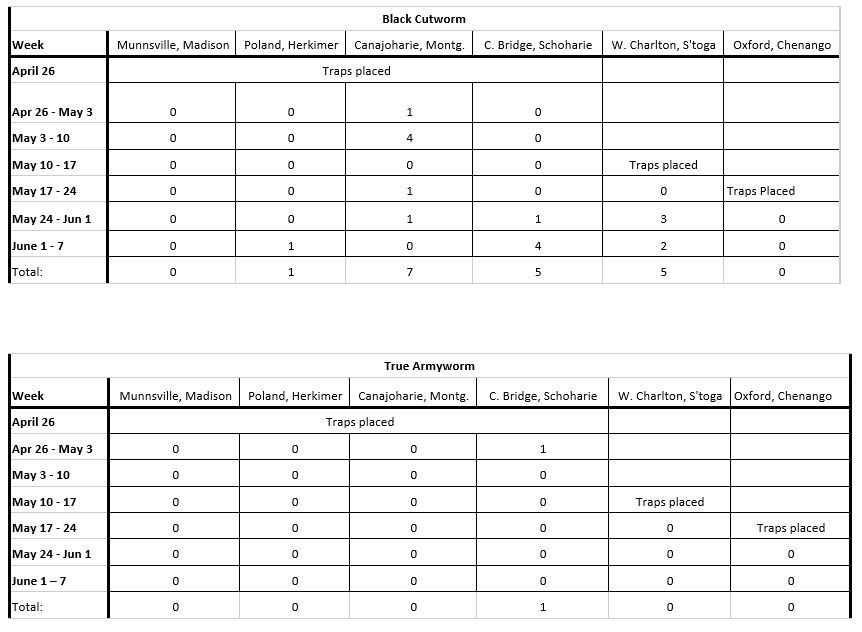
Trap captures of true armyworm have been relatively low across the state, but cutworm captures have been high in some locations in western NY and the north country (Lewis Co.). While we aren't seeing high numbers in either in our region, we should still be on the lookout for black cutworm damage. Damage begins ~300 GDD (base 50) from moth capture if there was substantial egg laying in the crop. There's no guarantee there will be, especially if your corn field is among other grassy habitats. Cutworm thresholds:
Corn at V2 stage (2 fully emerged leaves with leaf collars) - 2 cut plants per 100
Corn at V3 stage (3 fully emerged leaves with leaf collars) - 3 cut plants per 100
Corn at V4 stage (4 fully emerged leaves with leaf collars) - 5 cut plants per 100
Corn at V5 stage (5 fully emerged leaves with leaf collars) - 7 cut plants per 100
See this article for more information on cutworm damage and recommended products: NYS IPM Field Corn Pheromone Trapping Network for 2020 Caught Moths in Mid-April! - What's Cropping Up? Blog
Cutworm monitoring will continue for another week, after which we will continue monitoring true armyworm and begin to monitor for western bean cutworm in the pheromone traps.
I want to collect your fall armyworm adults and larvae! While Bt has done a good job of controlling fall armyworm on conventional corn here in the US, it's still a concern in our non-GMO corn and grass crops, and is a major invasive pest in other parts of the world. I'm teaming up with a group in southeast Asia who is studying this pest and its genetic variability around the world, so I'm looking for locations to place pheromone traps so I can collect specimens for them to evaluate. Let me know if you have a field that would be a good trapping candidate this summer, and regardless, please let me know if you encounter larvae:
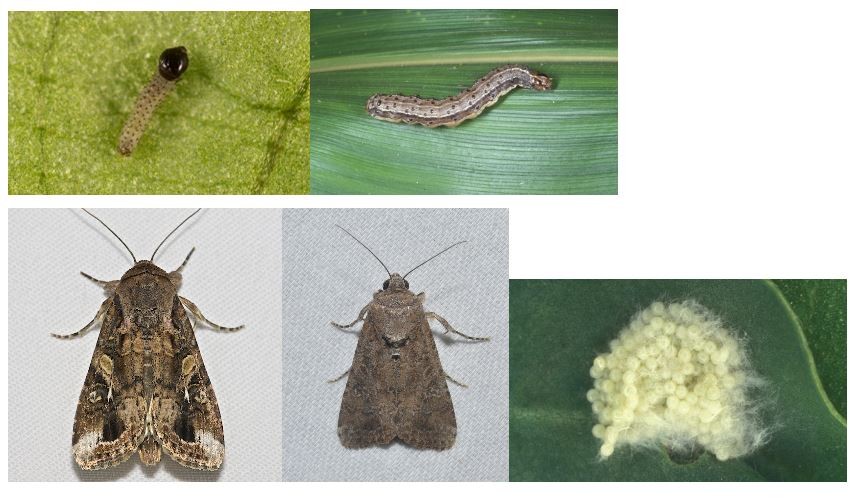
We want to collect your cereal leaf beetle larvae! Many of you have had issues with cereal leaf beetle in small grains. In the late 1960s and 1970s, USDA released a parasitoid that controlled cereal leaf beetle at very high levels. It was established and did a good job for many decades. In some parts of NYS there are very low levels of these parasitoids left. We are looking to reestablish them in those areas. In 2020 NYS IPM (Jaime Cummings) conducted a survey on the percent parasitism of cereal leaf beetle larvae in several areas of the state. We are looking to conduct the same survey in 2021 as well as continuing to develop a parasitoid insectary refuge on the Cornell Farm in Aurora. This can help us reestablish the parasitoid in areas of the state that might need them. If you have cereal leaf beetle in your fields please let Erik Smith (eas56@cornell.edu) or Ken Wise (klw24@cornell.edu) know and we can come and collect them. We will also let you know the rates of parasitism of the beetles in your fields.
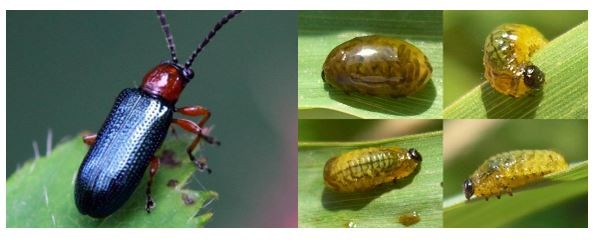
Field Crop Update June 1, 2021 (pdf; 660KB)
Upcoming Events
Labor Roadshow IX
December 1, 2025
December 9 - December 10, 2025December 17 - December 18, 2025December 22, 2025
In-person and online events to keep NY's agricultural employers informed and prepared for today's labor challenges.
Inspired by Annie's: How to Be a Strong Woman Farm Manager
January 10, 2026
January 17, 2026
Free webinars geared towards women who own or operate a farm in NYS.
2026 Dairy Day
January 13, 2026 : Dairy Day - Hamilton
Hamilton, NY
Lunch included
January 14, 2026 : Dairy Day - Ballston Spa
Ballston Spa, NY
Lunch included
Announcements
Statewide Field Crop Pathology Needs Assessment Survey
Your input is wanted for identifying priorities!Sign Up for Our Weekly E-Newsletter
We send out a bi-weekly e-newsletter that has announcements, upcoming programs, and opportunities for you! Registration is quick, easy, and free. Click here to sign up today!Farmers Can Join MeatSuite For Free!
MeatSuite.com is a free resource provided by Cornell University where NY meat farmers can create a farm profile and list their bulk (wholes, halves, quarters) and bundled (i.e. Grilling Bundle) meat products.Why should farmers join?
1. It's free and easy!
2. Connect with more local customers. In the past year the MeatSuite.com farm directory had 8,300 visits from New York consumers. Farm profiles get as many as 25 views per month from potential local customers. We also spotlight MeatSuite farms on social media and bring attention and purchases to farms through highlights and giveaways.
How do I join?
Farmers can visit https://www.meatsuite.com/farmers/ to create a free farm profile. You must list at least one product for your farm's profile to go live. You'll also have access to Cornell's free Meat Price Calculator, a helpful tool for pricing your meat to make a profit.
While you're on MeatSuite, check out the "Creating Consumer-Friendly Bulk Meats" publication on the log-in page. It has tips on how to create bulk meat products that are easier for first-time buyers to say "yes" to.
If you have any questions as you create your farm profile or products, we're here to help! Please email Matt LeRoux at mnl28@cornell.edu.

